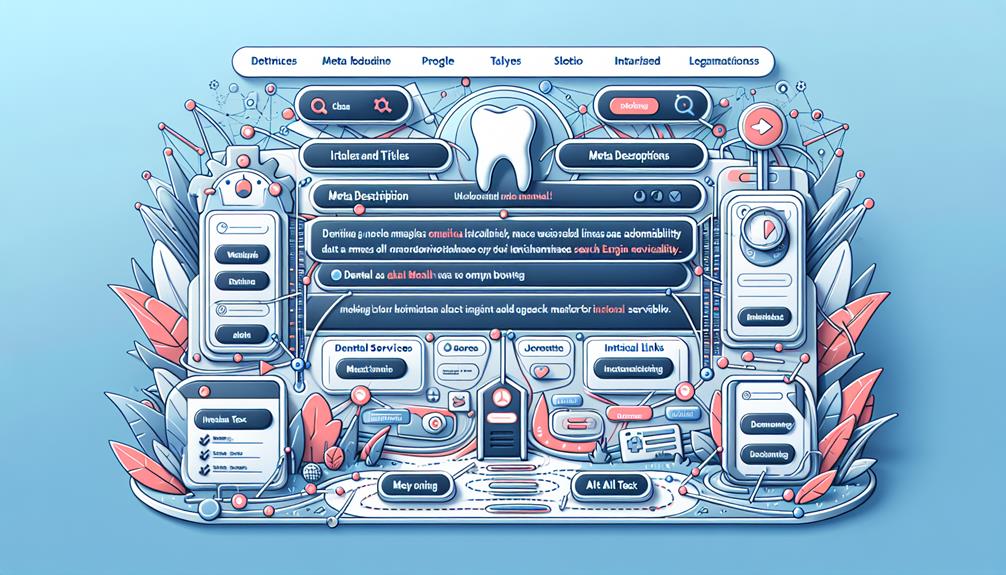When it comes to optimizing your dental website for search engines, there are specific on-page practices that can significantly impact your online visibility.
From keyword research to mobile-friendly design, each element plays a crucial role in how your website performs in search engine results.
Discovering the best strategies for on-page SEO for dental websites could be the key to attracting more patients and growing your practice.
Keyword Research
When optimizing your dental website for search engines, identifying the right keywords is crucial for attracting potential patients to your practice. Conducting thorough keyword research involves delving into long tail keywords and performing competitive analysis. Long tail keywords are specific phrases that target a narrow audience, making it easier for your website to rank higher in search results.
By analyzing your competitors’ keywords, you can uncover valuable insights and opportunities to refine your own keyword strategy.
In addition to long tail keywords and competitive analysis, focusing on local SEO and understanding keyword intent are essential for boosting your website’s visibility. Local SEO helps your practice appear in local searches, especially important for attracting nearby patients.
Keyword intent refers to the reason behind a search query, whether informational, navigational, or transactional. By aligning your keywords with the intent of potential patients, you can drive more qualified traffic to your website and increase the likelihood of converting visitors into actual patients.
Content Optimization
To optimize your dental website for search engines effectively, focus on strategically optimizing your content. Content optimization plays a crucial role in improving your website’s visibility and ranking. Incorporating relevant keywords related to dental services within your content can help search engines understand the focus of your website. Ensure that your content is informative, engaging, and tailored to meet the needs of your target audience searching for dental services.
Link building is another essential aspect of content optimization. By acquiring quality backlinks from reputable websites in the dental industry, you can enhance your website’s authority and credibility in the eyes of search engines. Encouraging social media engagement by sharing your content on platforms like Facebook, Instagram, and Twitter can also boost your website’s visibility and attract more traffic.
Meta Tags and Descriptions
For optimal search engine optimization of your dental website, ensure your meta tags and descriptions are strategically crafted with relevant keywords to enhance visibility and attract potential patients. Meta tags and descriptions play a crucial role in improving your SEO strategy and increasing your website’s visibility on search engines.
Here are some key points to consider:
- Keyword Placement: Incorporate relevant keywords naturally into your meta tags and descriptions to signal search engines about your website’s content.
- Length Optimization: Keep your meta descriptions concise yet informative to entice users to click through to your site, ultimately boosting your click-through rate.
- Engaging Descriptions: Craft compelling meta descriptions that not only include keywords but also encourage user engagement by providing a clear and enticing summary of your dental services.
URL Structure
After optimizing your meta tags and descriptions with relevant keywords on your dental website, the next crucial step is structuring your URLs effectively to further boost your site’s search engine visibility. SEO friendly URLs play a significant role in improving your dental website’s ranking factors. When creating URLs, ensure they’re concise, descriptive, and contain relevant keywords that reflect the content of the page. Avoid using generic URLs that don’t provide any insight into the webpage’s content.
URL parameters can sometimes create issues for search engines, leading to duplicate content problems. To tackle this, use canonical tags to indicate the preferred version of a URL when multiple URLs have similar content. Canonical tags help search engines understand which version of the URL should be indexed, consolidating the ranking signals for that particular page.
Image Optimization
When optimizing your dental website for search engines, incorporating image optimization techniques is essential for enhancing user experience and boosting your site’s visibility. To ensure your images are SEO-friendly, consider the following:
- Importance of Alt Text: Adding descriptive alt text to your images not only improves accessibility for visually impaired users but also provides search engines with context about your images, helping them understand the content of your page better.
- Optimizing Image File Size: Large image files can slow down your website’s loading speed, negatively impacting user experience and SEO. Compressing images without compromising quality is crucial for faster load times.
- Choosing the Right Image Format: Selecting the appropriate image format, such as JPEG, PNG, or WebP, based on the type of image can further optimize your website’s performance and SEO rankings.
Internal Linking
Incorporating internal linking strategically within your dental website can further boost its visibility and enhance user experience. When implementing internal links, focus on an anchor text strategy that includes relevant keywords related to your dental services or content. By using descriptive anchor texts, such as ‘best dental implants’ instead of ‘click here,’ you can improve the overall SEO value of your website.
Moreover, internal linking helps in distributing link juice throughout your site, ensuring that all pages receive their fair share of SEO benefits. This not only enhances the authority of individual pages but also strengthens the overall domain authority of your dental website.
Additionally, internal linking opens up new link building opportunities within your content. You can strategically link to other relevant pages within your site, creating a network of interconnected information that search engines can easily navigate. By leveraging internal links effectively, you can guide visitors to more valuable resources on your website, ultimately improving user engagement and SEO performance.
Mobile-Friendly Design
Ensure your dental website boasts a responsive web design that adapts to various screen sizes seamlessly.
User-friendly navigation is key to enhancing the mobile experience for visitors searching for dental services.
Prioritize a mobile-friendly design to improve user engagement and boost your site’s search engine rankings.
Responsive Web Design
Wondering how to make your dental website accessible and user-friendly on mobile devices? To enhance your site’s mobile responsiveness and improve user experience, consider the following:
- Implement a responsive design: Ensure your website adapts seamlessly to various screen sizes for optimal viewing on mobile devices.
- Prioritize fast loading times: Speed is crucial for both user experience and SEO benefits, so optimize your site for quick loading on mobile.
- Simplify navigation: Make it easy for mobile users to find information by organizing content logically and using intuitive menus.
User-Friendly Navigation
To optimize your dental website’s mobile user experience, streamline navigation to enhance accessibility and engagement. Ensure fast page load speed to keep users engaged and improve usability.
Simplify menu structures and use clear labels to help visitors find information easily. Keep the design clean and uncluttered, focusing on user-friendly layouts that work well on mobile devices.
Place prominent call-to-action buttons strategically throughout the site to encourage user interaction. Make sure that the design is responsive and adapts seamlessly to different screen sizes, providing a consistent experience across devices.
Frequently Asked Questions
How Important Is It to Have a Blog on a Dental Website for SEO Purposes?
Having a blog on your dental website is crucial for SEO benefits. Blog content enhances user engagement, improves website design, and boosts your search engine rankings. Regularly updating your blog with relevant topics can significantly impact your online visibility.
What Role Does User Experience Play in On-Page SEO for Dental Websites?
Boost your dental site’s SEO with user experience. Did you know, 53% of mobile users abandon sites after 3 seconds? Prioritize mobile responsiveness, fast loading times, intuitive navigation, and readable content to excel.
Should Dental Websites Focus on Local SEO Tactics to Attract Patients in Their Area?
Focus on local engagement for your dental website by implementing community outreach strategies. By targeting local SEO tactics, you can attract patients in your area effectively. Enhance your online presence and connect with nearby individuals.
How Can Social Media Presence Impact the SEO of a Dental Website?
Boost your dental website’s SEO with a vibrant social media presence! Engage with your audience, share valuable content, and encourage online reviews. Watch your SEO soar as social media engagement drives traffic and boosts visibility.
Are There Any Specific SEO Strategies That Are Unique to Dental Websites Compared to Other Industries?
When focusing on dental websites in SEO, consider unique strategies like targeting dental-specific keywords and ensuring mobile optimization. These practices can set your dental site apart, attracting more patients and improving search engine rankings.
Conclusion
Congratulations! You’ve mastered the art of on-page SEO for dental websites. Your keyword research is as precise as a dentist’s drill, your content optimization shines brighter than a freshly polished smile, and your meta tags and descriptions are as captivating as a winning smile.
Your URL structure is as straight as perfectly aligned teeth, your image optimization is as clear as a dental X-ray, and your internal linking is as strong as a dental bridge.
Keep up the good work and watch your website soar to the top of the search results!

Suraj Rana is a renowned Dental SEO Expert, deeply committed to elevating dental practices in the online landscape. With a profound understanding of technical SEO, he specializes in tailoring on-page optimization strategies specifically for the dental industry. Suraj’s extensive experience spans across various sectors, but his passion truly lies in transforming the digital presence of dental clinics. His expertise in dental-specific search engine optimization, combined with a data-driven approach, empowers him to develop strategies that significantly increase organic traffic, enhance search engine rankings for dental-related keywords, and ultimately drive business growth for his dental clients. Suraj Rana’s unique blend of SEO skills and dedication to the dental field make him an invaluable asset to any dental practice looking to thrive online.


